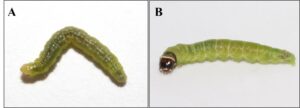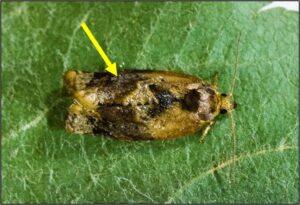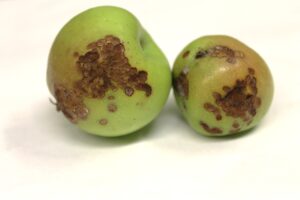For those growing apples with organic or “softer” pesticide programs, you might spot signs and symptoms of a hungry caterpillar that prefers to attack apple leaves and fruit: the redbanded leafroller (Figure 1). This particular apple pest is more often a problem in orchards where conventional insecticide sprays are not used. This season, I have received a few developing apples from an organic orchard that showed classic examples of feeding injury by caterpillars of the redbanded leafroller. As an extension entomologist and insect enthusiast, I wanted to share some images and a quick summary about this insect! And regardless of whether you are managing your apples conventionally or organically, it is always important to be able to recognize the signs and symptoms of insect pests, so you can apply the correct management strategies!
Adults are small (~0.5-0.6 inches long), fuzzy or velvety-looking moths, with a subtle V-shaped dark red and brown band that is visible on the forewings when the moth is at rest (Figure 1, arrow).
Caterpillars are ~0.75 inches long when mature, pale green in color and have a head capsule that is yellow or green (Figure 2). There are other fruit-eating caterpillars that you may spot on your apples, of course, but of those caterpillars that the redbanded leafroller may be most easily confused with, like the obliquebanded leafroller for example, our focal caterpillar is smaller in size and has a yellow or green head capsule, rather than a darker-colored one.

Figure 2. Redbanded leafroller caterpillar (A) and obliquebanded leafroller caterpillar (B)
Photo credit: MJ Hatfield, Bugguide.net.
Signs & symptoms. The caterpillars are, as usual, the damaging life stage. But can you blame them, apples are delicious! There are two key signs of redbanded leafroller caterpillars in your apple trees:
1) as the name suggests, the presence of rolled leaves. The caterpillars roll the leaves around themselves to feed and create a protective shelter against the elements and their predators. While spotting rolled leaves can be helpful as a clue, remember that there are other leaf-rolling caterpillars that may be active in apples too, like the obliquebanded leafroller I mentioned earlier. So, when you see rolled leaves, you can narrow it down to a leaf-rolling caterpillar of some kind, but you may need more information to confirm that it is the redbanded leafroller.
2) the presence of feeding injury on the surface of fruits. This is the classic symptom in my opinion, because while many caterpillars tunnel into the fruit and leave behind their solid waste (frass) as a sign of caterpillar feeding, the redbanded leafroller crawls along the surface of the fruit taking shallow “bites” from several places on a single fruit, with little to no frass left behind (Figure 3). I almost feel like I can see their little mandible (tooth) marks on the apples! I think this injury is pretty unique among the caterpillars feeding on apples and therefore it can be a helpful indicator of this caterpillar’s presence and injury on apples.
Pheromone-baited monitoring traps for the adults can be purchased from Great Lakes IPM. Capture of adult moths is most helpful for determining when you should begin looking for caterpillars, hatching from eggs laid by female moths. Conventional insecticides will manage the caterpillars, as well as Bt products, but remember Bt works best against the younger caterpillars, so timing and good coverage are key!

